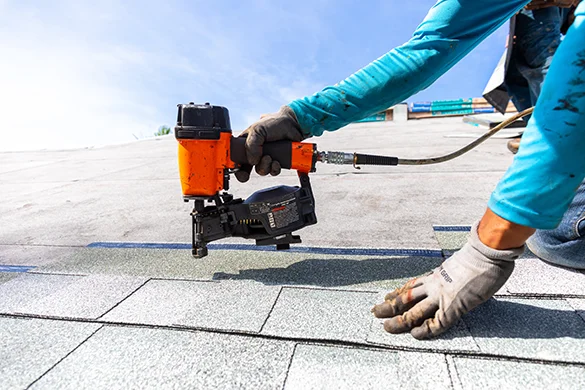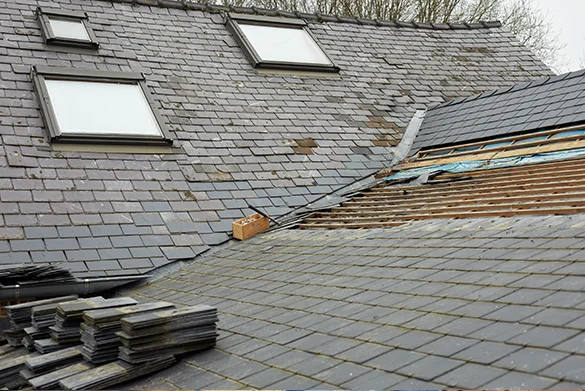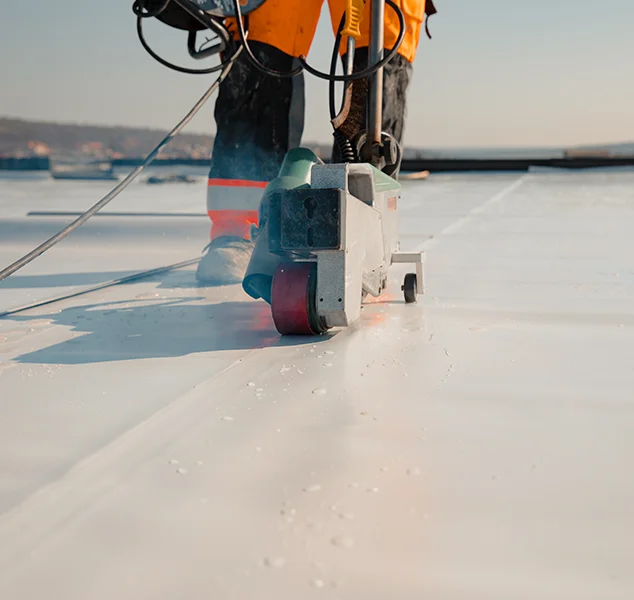How to Repair a Roof Leak in an Emergency: Temporary Fixes to Save Your Home
When water starts dripping through your ceiling during a storm, panic often sets in. While emergency roof leak situations demand quick action, knowing how to repair a roof leak temporarily can save your Northern Virginia home from extensive water damage while you arrange professional repairs. This guide covers proven emergency fixes that homeowners can safely implement when weather or timing prevents immediate permanent solutions.
Control Interior Water Damage First
Your first priority isn't fixing the roof—it's managing water already inside your home. Move furniture, electronics, and valuables away from the leak path immediately. Place buckets, plastic bins, or waterproof containers under all drip points. Use old towels or absorbent cloths to soak up standing water from floors, ceilings, and furniture surfaces.
If water is pooling in your ceiling and creating a bulge, carefully puncture the lowest point with a screwdriver to create controlled drainage into a bucket. This prevents sudden ceiling collapse and allows you to manage water flow. For active leaks during storms, set up a rotation of containers if overflow becomes an issue. Understanding common leaking roof repair mistakes helps you avoid making emergency situations worse.
Document everything with photos and videos for insurance purposes. Capture water entry points, interior damage, stains on ceilings and walls, and any personal property damage. This documentation proves essential for claims processing and helps roofing contractors understand the scope when they arrive.

Emergency Tarp Installation from Inside
When weather conditions make roof access dangerous, you can create temporary protection from inside your attic. This method works surprisingly well for localized leaks and keeps you safely off a wet, slippery roof during active storms.
Locate the leak source in your attic by following water trails on the underside of roof decking back to the entry point. Once found, slide a heavy plastic tarp or emergency roof patch material between the roof decking and insulation, extending it well beyond the leak point in all directions. The tarp should run from at least two feet above the leak down past the leak point, creating a waterproof barrier that channels water over the tarp's surface and away from the breach.
Weight the tarp's edges with boards or heavy objects in the attic to prevent it from shifting. This interior tarp won't stop the leak at its source, but it redirects water away from your living space, buying time until weather permits safe roof access. This technique works for asphalt shingle roofs, metal roofing, and other pitched roof systems where attic access exists.
Exterior Tarping When Conditions Allow
Once rain subsides and surfaces dry enough for safe access, exterior tarping provides superior protection for moderate to severe leak areas. Use heavy-duty polyethylene tarps rated at least 6-mil thick—the blue or silver poly tarps sold at hardware stores work well for temporary emergency repairs.
The tarp must extend from above the leak point (ideally over the roof ridge if possible) down past the leak and over the gutter line. This ensures water flowing down the roof runs over the tarp's surface rather than underneath it. Secure the top edge by sandwiching it between two boards fastened with screws into roof decking, creating a weather-tight seal.
Use sandbags, boards weighted with bricks, or water-filled containers to hold the tarp's sides and bottom edge in place. Never rely solely on stakes driven through the tarp into the roof—this creates dozens of new penetration points that can leak. For flat roof emergencies, weight the tarp edges thoroughly since there's no gravity assisting water flow away from the breach.

Quick Roof Cement Application for Small Breaches
For minor leaks from missing shingles, small cracks, or loose flashing, roofing cement provides effective temporary sealing when applied correctly. This method only works in dry conditions—roof cement won't adhere to wet surfaces, and rain will wash uncured product away before it seals.
Clean the leak area thoroughly, removing debris, loose granules, and any deteriorated material. The surface must be completely dry for adhesion. Apply a generous layer of roof cement or sealant rated for exterior use, extending the coverage several inches beyond the visible damage in all directions. For lifted shingles, carefully lift the damaged shingle, apply cement underneath, press firmly, then add another layer of cement over the edges.
Missing shingles require a slightly different approach. Cut a piece of sheet metal or galvanized flashing to size, slide it under the shingle course above the gap, and cement it in place. This creates a temporary water barrier until proper shingle replacement can occur. While effective for days or weeks, cement-only repairs aren't permanent solutions and will eventually fail under UV exposure and temperature cycling.
Emergency Patch Kits for Flat Roofs
Flat roof emergencies demand different techniques than sloped roofs. Rubber membrane systems like EPDM and thermoplastic membranes like TPO can often be temporarily patched using emergency repair kits available at roofing supply stores.
Clean and dry the damaged area thoroughly—this is critical for patch adhesion. EPDM repair kits include rubber patches and specialized primers and adhesives formulated for emergency applications. Follow manufacturer instructions precisely regarding surface preparation, primer application, and patch placement. Apply heavy pressure using a roller or hand pressure to eliminate air bubbles and ensure complete contact.
TPO and PVC roofing systems benefit from heat-activated patches if you have access to a heat gun designed for roofing work. These patches create superior bonds but require some expertise. If unsure, adhesive-based emergency patches provide adequate temporary protection. For commercial buildings with substantial flat roof areas, calling emergency roofing services often proves more cost-effective than DIY attempts on complex membrane systems.

Safety Considerations Cannot Be Compromised
Emergency roof repairs often happen under stressful conditions, but safety must remain the top priority. More homeowners are injured attempting emergency roof access than suffer damage from waiting for professional help. Wet roofs become incredibly slippery—a lesson learned too late by many who've fallen.
Never attempt roof access during active weather, high winds, or on wet surfaces. If the roof pitch exceeds what you're comfortable navigating, stay off it. Steep roofs require fall protection equipment and experience that most homeowners lack. Darkness compounds dangers exponentially—wait for daylight even if that means another night of bucket rotation inside.
Use proper ladder technique: extend the ladder three feet above the roof edge, secure the base, and maintain three-point contact while climbing. Have someone foot the ladder from below. Wear shoes with excellent traction, never work alone, and keep your phone accessible in case of emergency. For complex situations or dangerous roof configurations, the wisest emergency response is controlling interior damage and calling professionals. Understanding when to attempt DIY fixes versus when to hire experts is covered in roofing repair specialists vs DIY decisions.
Planning for Permanent Repairs
Emergency fixes buy time—they're not permanent solutions. Once you've stabilized the immediate situation, contact qualified roofing contractors to schedule proper repairs. Northern Virginia's weather patterns mean that temporary patches applied in spring may need to survive summer heat, fall rain, and winter freeze-thaw cycles if you delay permanent work.
Get multiple estimates and don't feel pressured to hire the first contractor who can start immediately. Storm-chasing contractors often appear after severe weather, offering "emergency repairs" at inflated prices with substandard work quality. Verify licensing, insurance, local references, and Better Business Bureau ratings before committing.
Understanding whether your situation requires spot repairs or complete replacement helps you plan appropriately. Our guide on comprehensive roof leak repair walks through the decision process. For older roofs showing multiple problem areas, investing in proper replacement often costs less long-term than repeated emergency repairs. The key is making informed decisions once the immediate crisis passes.
When to Call Emergency Roofing Services
Some situations exceed safe DIY capabilities and require immediate professional intervention. Structural damage visible in the attic, multiple active leaks, large sections of missing shingles, or damage to flashing around chimneys and vents all warrant professional emergency services regardless of weather or timing.
Commercial buildings, multi-story homes, or properties with complex roof designs similarly demand professional response. The risks of improper emergency repairs often exceed the cost of emergency service calls. Many Northern Virginia roofing contractors offer 24-hour emergency response for severe situations—a worthwhile investment when substantial property damage looms.
Need Emergency Roof Leak Repair in Northern Virginia?
Our experienced team provides fast emergency response and permanent solutions for all roof types throughout the Northern Virginia area.
Get Emergency Help Now